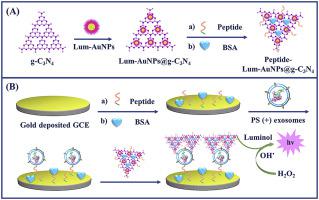Talanta ( IF 5.6 ) Pub Date : 2020-07-18 , DOI: 10.1016/j.talanta.2020.121379 Xuejiao Liu , Qiaoe Wang , Jun Chen , Xu Chen , Wensheng Yang

|
Highly sensitive determination of tumor exosomes is significant for early diagnosis of cancers and precision therapy. Herein, a sandwich peptide-based electrochemiluminescence (ECL) biosensor was developed for determination of phosphatidylserine (PS)-positive exosomes, a promising biomarker for early diagnosis of ovarian malignancy. A PS-specific binding peptide with high affinity was immobilized on Au nanoflowers (AuNFs) modified biosensing interface for recognition and capture of exosomes. Meanwhile, g-C3N4 nanosheet loaded with luminol capped AuNPs (Lum-AuNPs@g-C3N4) nanocomposite was used as the ECL signal nanoprobe. The g-C3N4 nanosheets with large surface area were not only utilized as the carrier to immobilize more peptides for recognition of exosomes but also used to catalyze co-reactant H2O2 decomposition to achieve the ECL signal amplification of luminol-H2O2 system. Under optimal conditions, the biosensor showed superior performances compared with most currently available methods, including wider linear range across 5 orders of magnitude and a lower detection limit (LOD) down to 39 particles μL−1. Moreover, the biosensor could be applicable for determination of exosomes in complex biological samples. This study indicates the combination of peptide recognition with nanoprobe as a label for signal amplification in sandwich ECL biosensing is a great promising strategy for sensitive and cost-effective determination of exosomes.
中文翻译:

基于肽识别和luminol-AuNPs @ g-C3N4纳米探针信号放大的超灵敏化学发光生物传感器,用于检测肿瘤外泌体
肿瘤外泌体的高灵敏度测定对于癌症的早期诊断和精确治疗具有重要意义。在本文中,开发了一种基于三明治肽的电化学发光(ECL)生物传感器,用于测定磷脂酰丝氨酸(PS)阳性外泌体,这是早期诊断卵巢恶性肿瘤的有希望的生物标记。具有高亲和力的PS特异性结合肽被固定在Au纳米花(AuNFs)修饰的生物传感界面上,用于识别和捕获外泌体。同时,GC 3 Ñ 4纳米片装载有鲁米诺封端的AuNP(LUM的金纳米粒子@ GC 3 Ñ 4)纳米复合材料被用作ECL信号纳米探针。gC 3 N 4具有大表面积的纳米片不仅被用作载体以固定更多的肽以识别外泌体,还被用于催化共反应物H 2 O 2分解以实现鲁米诺-H 2 O 2系统的ECL信号放大。在最佳条件下,与目前大多数可用方法相比,该生物传感器表现出卓越的性能,包括跨5个数量级的更宽线性范围和更低的检测限(LOD),低至39个颗粒μL -1。此外,该生物传感器可适用于测定复杂生物样品中的外来体。这项研究表明,将肽段识别与纳米探针作为三明治式ECL生物传感中信号放大的标记物的组合,对于灵敏且经济高效的外泌体测定是一种很有前途的策略。











































 京公网安备 11010802027423号
京公网安备 11010802027423号